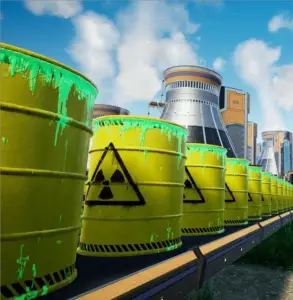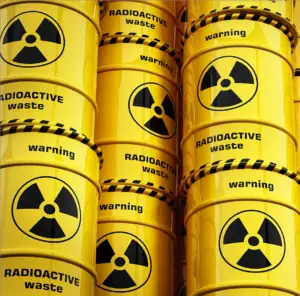
Introduction
- India’s advancement in its nuclear program, marked by the operation of the Prototype Fast Breeder Reactor (PFBR), underscores the nation’s commitment to harnessing nuclear energy.
- However, as India progresses towards utilizing thorium in its nuclear endeavors, the issue of nuclear waste management looms large.
Understanding Nuclear Waste
- Defining Nuclear Waste:
- Exploring the nature of radioactive materials and their origins in nuclear reactors.
- Fission Process:
- Understanding how nuclear waste is generated through the fission process.
International Conventions
- Bamako Convention:
- Examining the African treaty aimed at curbing the import of hazardous waste, including radioactive materials.
- Joint Convention on Spent Fuel and Radioactive Waste Management:
- Delving into the global treaty established by the International Atomic Energy Agency (IAEA) to address the safe management of radioactive waste.
- Convention on Nuclear Safety (CNS):
- Exploring the framework aimed at enhancing nuclear safety standards worldwide.
Techniques in Nuclear Waste Handling
- Spent Fuel Storage:
- Analyzing the methods of storing spent fuel, including underwater storage and dry cask storage.
- Liquid Waste Treatment:
- Discussing the treatment processes employed by nuclear power plants for liquid waste disposal.
- Vitrification and Reprocessing:
- Exploring advanced techniques such as vitrification and reprocessing for managing high-level radioactive waste.
Challenges and Issues
- Radioactive Pollution:
- Highlighting the environmental and health risks posed by radioactive materials.
- Storage Challenges:
- Addressing the complexities of long-term storage and disposal of high-level nuclear waste.
- Safety Concerns:
- Discussing the risks associated with transporting and storing nuclear waste, including accidents and security threats.
- Financial Burden:
- Examining the economic costs of nuclear waste management and its impact on energy production.
Nuclear Waste Management in India:

- On-Site Management:
- Exploring India’s approach to handling nuclear waste generated at power stations.
- Reprocessing Facilities:
- Highlighting India’s reprocessing capabilities and facilities located in Trombay, Tarapur, and Kalpakkam.
- Regulatory Oversight:
- Discussing India’s adherence to International Atomic Energy Agency (IAEA) safeguards and monitoring measures.
Conclusion
As India forges ahead with its nuclear ambitions, effective management of nuclear waste emerges as a critical imperative. By understanding the techniques, conventions, and challenges associated with nuclear waste management, policymakers and stakeholders can chart a sustainable path towards harnessing nuclear energy while safeguarding human health and the environment.
People also ask
Q1: What is nuclear waste, and how is it generated?
Ans: nuclear waste, also known as radioactive waste, comprises materials containing radioactive isotopes that are no longer useful for their original purpose. It is generated through the fission process in nuclear reactors, where atoms of certain elements are bombarded by neutrons, leading to the production of radioactive byproducts.
Q2: What are some international conventions addressing nuclear waste?
Ans: Key conventions include the Bamako Convention, prohibiting the import of hazardous waste, including radioactive materials, into Africa. The Joint Convention on Spent Fuel and Radioactive Waste Management focuses on global standards for radioactive waste management. Additionally, the Convention on Nuclear Safety aims to enhance global nuclear safety standards.
Q3: What are the primary techniques used in waste handling?
Ans: Techniques include spent fuel storage, initially underwater for cooling before transferring to dry casks. Liquid waste treatment processes waste from nuclear plants before release. Advanced methods like vitrification and reprocessing manage high-level radioactive waste.
Q4: What are the main challenges associated with waste management?
Ans: Challenges include radioactive pollution, posing environmental and health risks. Storage challenges arise due to long-term radioactive waste. Safety concerns involve transportation accidents, requiring stringent measures. Additionally, the financial burden impacts energy production.
Q5: How does India manage waste within its nuclear program?
Ans: India employs on-site management strategies for handling waste generated at nuclear power stations, coupled with reprocessing facilities located in Trombay, Tarapur, and Kalpakkam. These facilities play a crucial role in processing spent fuel and managing radioactive waste. India also adheres to IAEA safeguards and monitoring measures to ensure the safe and secure handling of nuclear materials and waste.
Your article helped me a lot, is there any more related content? Thanks!
Thanks for sharing. I read many of your blog posts, cool, your blog is very good.